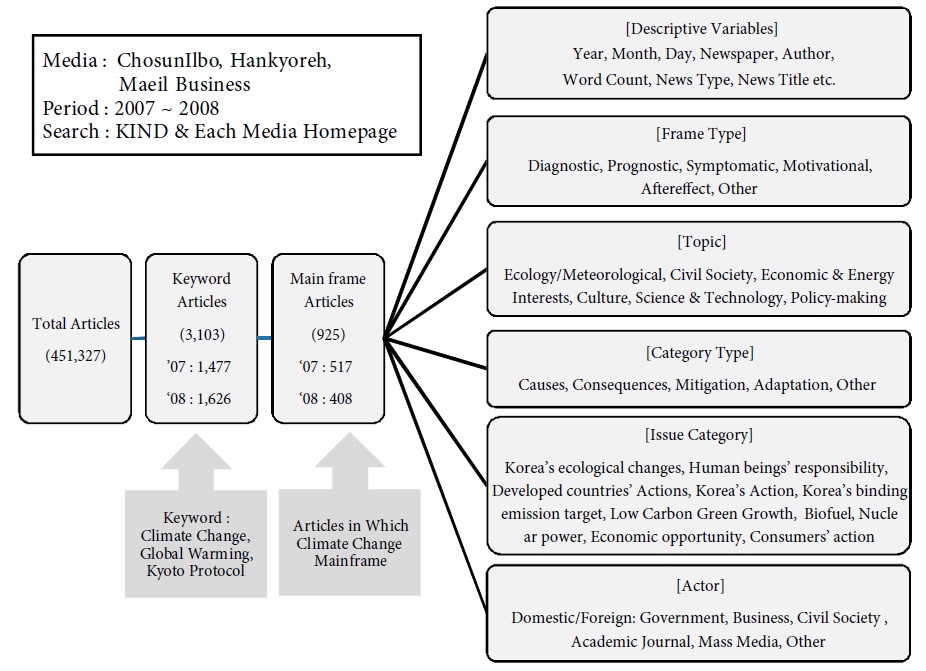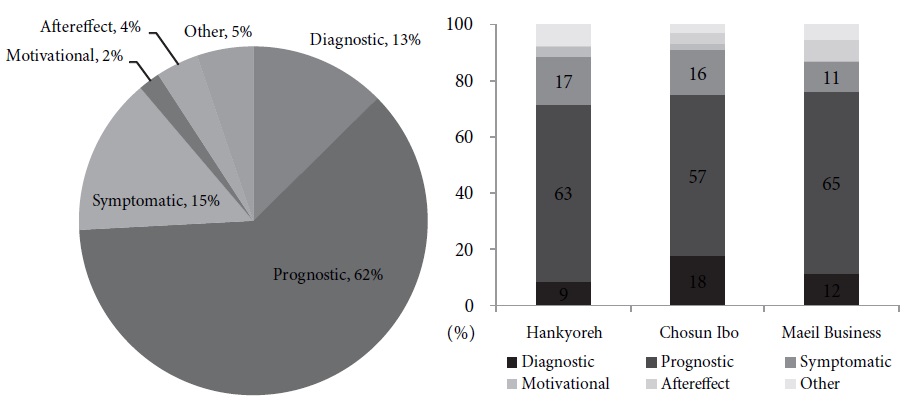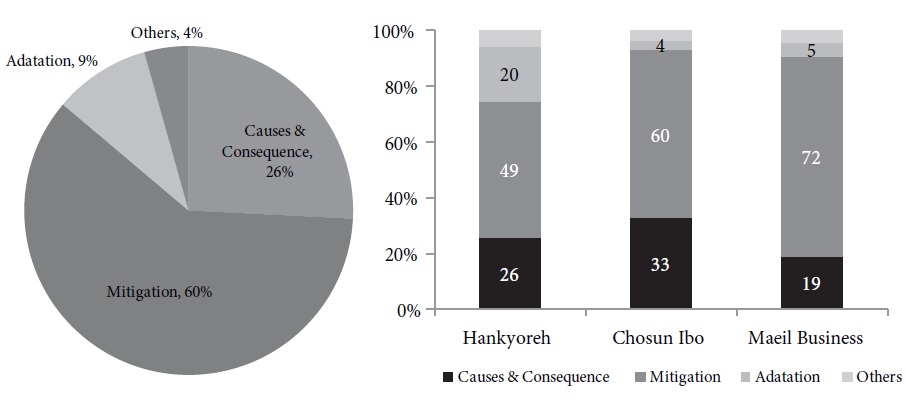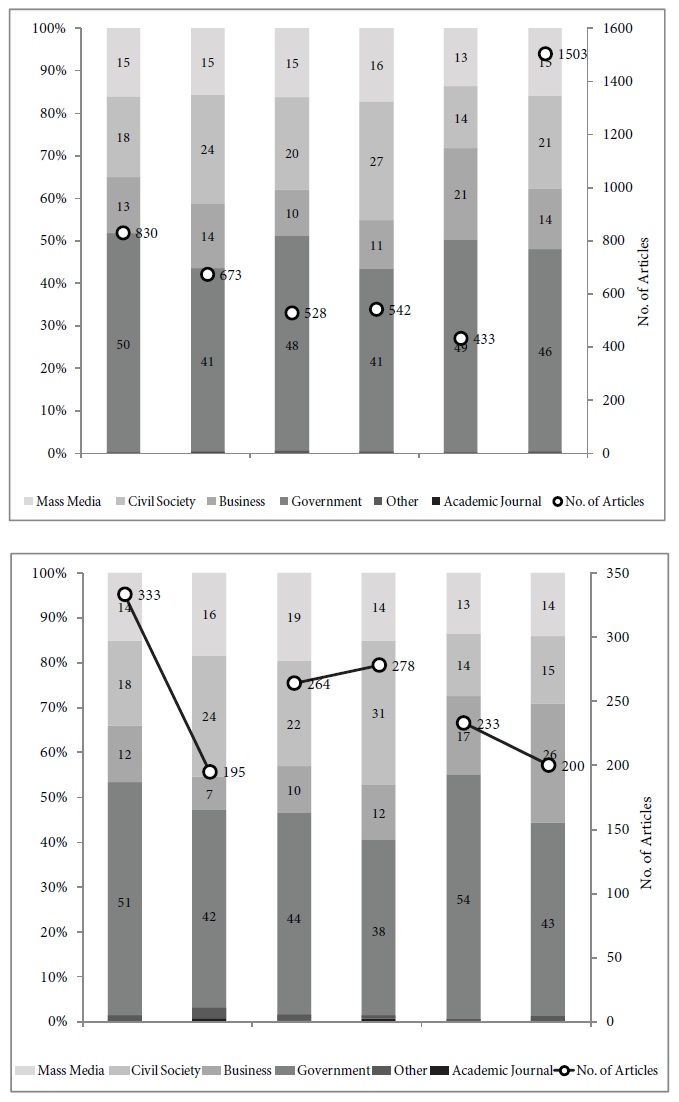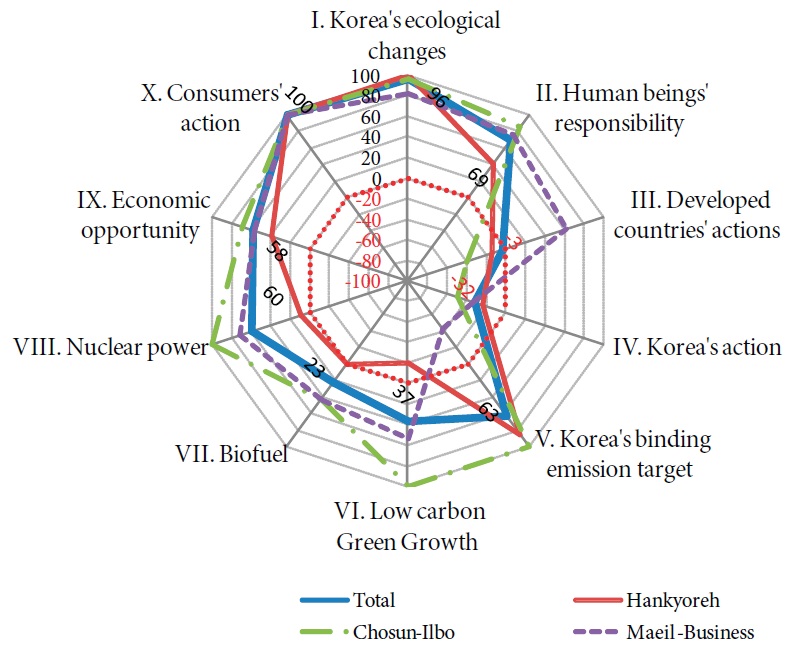


This paper compares and analyzes the contents and sources of news articles on climate change in three major South Korean newspapers between 2007 and 2008. Chosunilbo, Hankyoreh, and Maeil Business were selected as subjects for this study because these three newspapers are representative of the conservative, progressive, and economic newspapers in South Korea, respectively. The key questions asked in this paper are as follows: 1) How do these selected newspapers portray climate change? 2) What kind of sources do they cite, and how do these sources differ? 3) What kind of solutions do the newspapers recommend in dealing with climate change? South Korean press has handled the climate change issue largely from a prognostic frame, placing emphasis on reports concerning policy determination and mitigation policies. The most frequently cited source in all the newspapers was the government. There were differences in the emphasis of each newspaper, however: The conservative newspaper and the business newspaper both supported the policy of sustaining capitalistic economic growth while maintaining existing economic and social structures. The progressive newspaper called for active reduction in the amount of GHG emissions and took a critical position on high-risk and big technologies such as nuclear power generation.
Following the establishment of the United Nations Framework Convention on Climate Change (UNFCCC) in 1992, there has been a worldwide increase in newspaper coverage of climate change (Boykoff 2007, 2008; Boykoff and Mansfield 2008; Brossard, Shanahan, and McComas 2004; Carvalho 2005; Doulton and Brown 2009; Klinsky 2007; McDonald 2009; Olausson 2009; Zehr 2009). In 2007, news coverage skyrocketed after the Intergovernmental Panel on Climate Change (IPCC) announced its fourth assessment report (AR4) (Broadbent and Fisher 2010), accompanied by a drastic change in the overall content of climate change coverage. Whereas the global media of the 1990s and early 2000s was littered with publications that questioned the science behind climate change, coverage in the past decade has focused less on the credibility of the climate change scenario and more on dealing with solutions and policies (Zehr 2009).
The mass media plays an important role in publicizing socially important environmental problems and in initiating discussions about solutions (Olausson 2009). News coverage of climate science and policy has considerable impact on the public’s understanding of relevant issues and has both direct and indirect implications for policy-making processes (Wilson 1995; Boykoff and Mansfield 2008; McDonald 2009). Thus, media analysis is a powerful method of exploring how environmental issues are able to gain social value through the interaction of various interest groups (Anderson1997). Media analysis does not focus on the story told by an article; rather, it studies the narration process of the article and the ways it is reconfigured by human, systematic, and technological networks. From this perspective, we analyzed how the mass media in South Korea frames climate change, kinds of contents it includes, and types of speakers it cites.
South Korea maintains a unique status with regard to international climate change policy because it belongs to the OECD but is categorized as a non-Annex I country under the UNFCCC and is under international pressure to take more active climate actions. Because of its unique position, South Korea’s response to climate change and its role in international negotiations may have significant impact on developing and advanced developing countries. Consequently, domestic media coverage of the climate change issue has grown steadily. In this context, it is meaningful to examine the construction of South Korea’s discourse on climate change through news media venues.
What perspectives constitute South Korea’s view on climate change? Do South Koreans view it as a scientific and ecological issue, a socio-economic issue, or both? Which organizations and speakers are most commonly cited? What kind of solutions do they suggest for dealing with climate change? By answering these questions, this study draws a general map of the discursive environment surrounding climate change in South Korea. Because it has implications for the policies, societies, and economies of all nations, climate change is already a core part of global politics, making the analysis of its underlying discourse a significant undertaking.
This study approaches the above questions through analysis of articles related to climate change in three major South Korean newspapers from 1995 to 2008.1 In particular, this study focuses on 2007 and 2008, the two years that saw a rapid increase in the number of relevant articles. Relevant articles from 2007 and 2008 account for nearly 50 percent of the total number of published articles related to climate change from 1995 to 2008. In addition, a number of important policy events occurred between 2007 and 2008: Internationally, the Bali Road Map was adopted in COP-13, the AR4 was announced by IPCC, and the Nobel Peace Prize was jointly awarded to IPCC and Al Gore; domestically, a turnover in political power led to an announcement made by the Lee Myung-bak administration that set “low-carbon green growth” as the national goal.
Background of Climate Discourses in South Korea, and Study Questions
>
Background of Climate Discourses in Korea
Apart from Mexico, South Korea is the only country awarded the status of non-Annex I Party among OECD member countries. However, in terms of greenhouse gas (GHG) and accumulated emissions, South Korea struggles to assert its status as a developing country. As of 2008, its rate of annual CO2 emissions from fuel combustion is sixth among OECD member countries and ninth in the world (IEA 2010), and its accumulated emissions (1850-2002) rate is 23rd in the world (WRI 2005). South Korea’s carbon emissions per capita ranked 13th among OECD member countries and 26th in the world in 2008. Its 103 percent increase in emissions from 1990 to 2007 was also the highest in OECD member countries. South Korea’s emissions status results from the energy-intensive industrial structure and rapid economic growth. Regarding climate change, South Korea is quickly moving from being a creditor nation to a debtor nation, and is thus expected to participate in emissions reduction duties in the post-Kyoto system.
South Korea entered into the UNFCCC in 1993 and submitted the 1st National Communication to the UNFCCC in 1998. The Comprehensive Plan on Combating Climate Change has been prepared every three years from 1999 to 2007 (the first, second, and third), and it has been prepared every five years since 2008 (the fourth). From 1999 to 2007, Republic of Korea’s responses to climate change policies were fairly modest and protective because of its concern about the economic burdens of climate change policies. The transition of leadership from the Roh Moo-Hyun government to the current Lee Myung-bak government in February 2008 brought with it a change in these national policies. South Korea’s new proactive stance on climate change coincides with increased international climate change activity since the year 2000. Climate change gained presence as an important issue in international gatherings and policies, representative of which are the G8 Summit and the 2005 Kyoto Protocol. President Lee, in his August 2008 speech for the 60th anniversary of national independence, announced a policy of lowering carbon emissions coupled with “green” economic growth as a “new national development paradigm.” Prior to this event, President Lee announced at the G20 held in Toyako, Japan in July 2008 that Korea will be an “early mover” with regard to climate change response and promised to establish a GHG reduction target by 2009.
In addition, the Korean government has defined nuclear power as an option for low-carbon green energy and has supported its expansion as one of the most important climate mitigation options under the reasoning that nuclear energy is carbon-free and supplies abundant electricity at affordable prices (Yun 2012). Nuclear energy use in Korea has been expanded due to limited domestic fossil fuel resources, growing energy needs, and the desire to export nuclear technologies as a new growth engine. Currently, however, climate change legitimizes nuclear expansion as a proper response to climate change.
Is discourse around climate change made up of neutral frames, such as “our common future,” that avoid explicitly conservative or progressive stances, or has it become a discourse that reifies partisan political divisions? Does climate change unite or divide socio-economic classes in terms of the stakes of climate change action? Ulrich Beck (1992) describes a situation in which all classes and groups share risks from catastrophes, such as the Chernobyl disaster, as contributing to the formation of a “risk society.” From this perspective, the climate change issue can be presented by global discourses that go beyond socio-economic differences. From the perspective of environmental justice (Tokar 2010; Ikeme 2003), we find that climate change, as a global risk, has implications and consequences that are unequally distributed across multiple lines of difference, only one of which is the socioeconomic status of the communities it threatens. Thus, as long as global society’s social structure remains one of inequality, risks and benefits will remain unequally distributed. In regards to the controversial issue of climate change, however, what position has been taken by Korean newspapers? Which aspect of climate change have they emphasized—the common aspect of climate threat, or its unjust and unequal aspect? Do Korean newspapers see climate change as a matter requiring social restructuring or technological treatments? In light of both theoretical and practical concerns about climate change in these contexts, this study addresses the following three questions.
The media molds the general public’s perception of society and important issues through “framing” (Han 2001).2 The function of framing can be understood as that of a vista or window which defines the limit of important questions, channeling attention to the most crucial factors (Tankard et al. 1991). For example, British and American media analysis of climate change has focused heavily on the debate over the validity of claims about the reality and threat of climate change. During the George W. Bush administration in the U.S., American television took a seemingly balanced stance by portraying both sides of the debate on whether mankind is responsible for climate change or not (Kuban 2008). English tabloids diverged from the stance held by major newspapers, conveying both sides of the question and reporting in agreement with the consensus of the scientific world (Boykoff and Mansfield 2008). An analysis of a number of respected newspapers in the United Kingdom and the United States revealed that the U.S. media used frames that contradicted the claims made by the scientific world, but this trend diminished with time. Another analysis found that major British newspapers agreed with the consensus of the scientific world in that climate change was a viable, and serious, global problem (Boykoff 2007). In British papers, discourse about climate change as a serious problem was found predominantly in progressive newspapers, while conservative papers tended to see climate change as a beneficial phenomenon and covered debates over development-related issues that were portrayed as more important than environmental concerns (Doulton and Brown 2009).
Further, media discourse on climate change is considerably influenced by governmental discourse on the subject. At the beginning of the twentyfirst century, U.S. moved away from the dispute of “uncertainty,” which pitted environmental issues against economic development issues, to adopt a hybrid frame that positions climate change policy as going hand-in-hand with economic policy. This trend mirrors the concurrent shift in the U.S. climate change policies (Zehr 2009). In the United Kingdom, newspaper and government discourses diverged, with most media coverage informed by a neoliberal framework that failed to criticize the consequences of unfaltering economic growth and consumption or to engage issues of international inequity (Carvalho 2005). In another example, Swedish newspapers reflected the active policies of Sweden and Europe as a whole to combat climate change, engaging the frame of “certainty” with regard to mankind’s accountability for climate change, with most articles favoring mitigation over adaptation (Olausson 2009). Based on this prior research, this study will examine the frames utilized by the South Korean media in its coverage of climate change.
What are the trends in Korean newspapers? Are there political divisions in understanding the nature of climate change? In general, there were few cases of media analysis in Korean newspapers concerned with the nature of climate change, particularly the global, common threat involving unequal distributional effects. In Korea, which aspect is more emphasized in newspapers?
The media holds great power in selecting and ushering social issues into the domain of public policy, making the issue of access to participation in media discourse an important concern. Because discourse on environmental issues such as climate change depends on the opinions of experts, the media generally favors government organizations and other institutional research organizations over environmental non-governmental organizations (NGOs) and independent researchers (Anderson 1997). National governments have been the main source of information concerning climate change, and in the case of the Canadian media, NGOs were seldom cited without another source. According to one analysis (Kuban 2008), government officials and political authorities played the largest role in U.S. television news coverage on climate change. Additionally, economic and social contexts influence the inclusion of certain types of speakers. For example,
So far, research on media coverage of climate change outside Western industrialized countries has been limited. Researching South Korea’s coverage provides an opportunity to broaden knowledge about how the frame of climate change operates in a global context. For example, it was found through an analysis of environment-related articles in South Korea’s ten major daily newspapers in the 1990sthat environmental organizations were increasingly cited in the later part of the decade (Shin 2002). A later analysis of headlines revealed actors of “national authority” were most frequently covered, while civil society actors were used marginally, generally in cases where there was a divergence of opinion between the conservative
Climate change is a threat to global communities, economies, and ecosystems. It is an especially large threat to economically disenfranchised communities which face difficulties in adapting to the changing climate. On the other hand, climate change provides opportunities for profits to those in this business sector if they can adapt adequately to changing markets and policies.
In such a situation where the benefits and the risks are so unevenly distributed, an issue even more salient in advanced developing countries like South Korea, what kind of policies does the news media advocate? If some newspapers are indifferent to the distributional aspects of climate actions and solutions, they tend to be more supportive of maintaining the conventional social structure. The initial expectation of this study is that conservative newspapers will suggest policies that will sustain economic growth while maintaining existing social structures. We expect that progressive newspapers will support policies that will uphold environmental justice by enhancing environmental rights of the socially and economically underprivileged; business newspapers will most likely suggest policies that will minimize the cost of climate change action and maximize profits for private businesses.
1We tried to analyze the trend of newspaper reports since 1992 when the UNFCCC was adopted in Rio instead of since 1995, but this was not feasible due to the fact that Maeil Business and Korea Integrated News Database System (KINDS) began to provide articles online as of 1995. 2On the other hand, the media delivers information neutrally and objectively but tends to convey particular interests and values (Phillips and Hardy 2002).
>
Collection of Data and Analysis Period
In South Korea, newspapers are still a major public sphere, and they strongly influence policymakers. In 2009, more than 70% of Korean people read printed newspapers, slightly more than those who read internet news (Statistics Korea 2011). Three of South Korea’s major daily newspapers were selected for analysis of their trends toward reports on climate change, major contents of their coverage, what sources they cite, what each newspaper’s major issues and stances are, and diversity of attitudes displayed in the articles of each newspaper. The three newspapers selected are
[Table 1] Summarized Analysis of Objects, Time Periods, and Methods
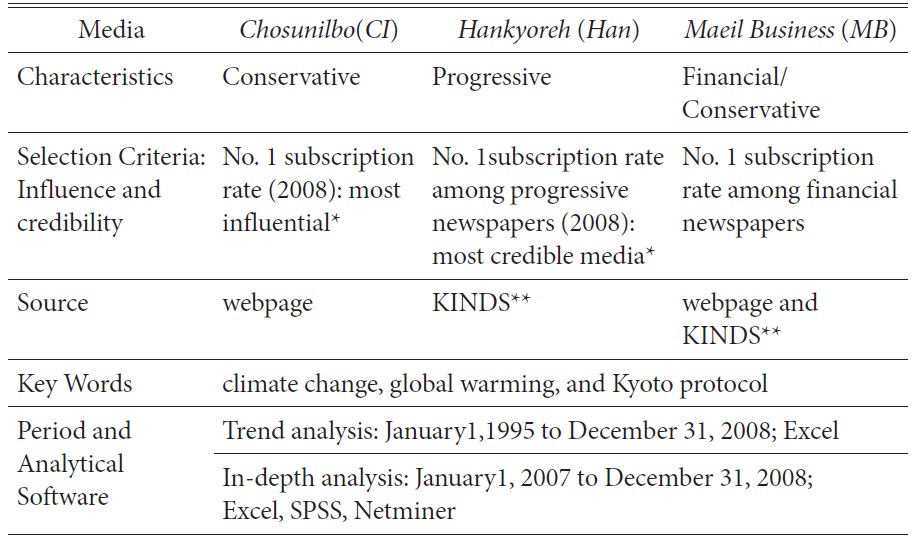
Summarized Analysis of Objects, Time Periods, and Methods
>
Results of Coding Credibility Test
Six coders analyzed selected climate change articles. In order to ensure credibility, inter-coder reliability was tested using the Holsti index for the rate of simple correspondence and, as an additional measure, the Kappa value for coincidental correspondence. Both values satisfied the standards for credibility (80% and 0.7, respectively) for each coding theme. The Holsti index measures the degree of simple agreement. If a coder scores more than 80 percent, his/her coding results are considered credible. The Kappa index tests chance agreement. If it is larger than 0.7, coding results are considered credible. In the credibility test used in this study, a Holsti test was administered, while the Kappa test was administered supplementally since there was a small probability of chance agreement during the coding process. In practice, if differences emerged, coders resolved them among themselves by holding meetings during the coding process. Specific results of these tests are shown in footnote.3 After the credibility test, coders analyzed newspaper articles based on a set of standardized coding guidelines.
Coding guidelines contain the criteria by which selected articles were analyzed, including frame types, topics/themes, and organizational types, all of which are shown in figure 1.
Based on the classification of frame types established by Benford and Snow (2000), frames were specifically designed to apply to climate change issues for this study, and as such, frame types were classified as diagnostic, prognostic, symptomatic, motivational, after-effect, and other: diagnostic frame analyzes climate change at the natural science and social science levels; prognostic frame covers the means of addressing or resolving the climate change issue; symptomatic frame deals with the various ecological, health, social changes caused by climate change; motivational frame is concerned with why climate change issue and corresponding search for solutions are important; finally, after-effect frame covers the results of implementing climate change countermeasures. These frame types represent the general framing mechanism found in all kinds of rhetoric and analysis of issues.
Topic categories indicate the aspect of climate change that constitutes the main theme of the articles. Topics were classified into six categories: ecology/meteorology, policy-making, economic and energy interests, culture, science and technology, and civil society. Articles were coded as an ecology/meteorological topic if they refer mostly to plants, animals, and issues on biodiversity, habitat, and/or weather events such as heat waves, droughts, floods, and weather trends. Articles were coded as a policy-making topic if they include individuals, processes, or claims of governance at any level, whether international or domestic, opposition to government, civil service, quasi non-governmental organizations, or local authorities. Articles were coded as economic and energy interests if they refer mostly to industry, commerce, markets, business groups, business lobbyists, specific products or spokespeople, and energy interests, along with the economic impact on society. Articles were coded as culture if they refer largely to lifestyles, practices of individual and community living, consumption patterns, and popular culture including films, books, and celebrities. Furthermore, topic of culture also includes the impact of climate change on lifestyles. Articles were coded as science and technology when they refer mostly to discoveries, fundamentals, new studies, release of scientific reports on applied science, and new technologies. Topic of science and technology also includes discussion of any scientific findings, scientific controversy, change in science, science reports, etc. Articles were coded as civil society when they refer to civil law claims, campaigns and protests (i.e., demonstrations, direct action, email campaigns, etc.), public opinion polls, and consumer reports.
Category types for coverage of climate change were classified as causes, consequences, mitigation, adaptation, and other. Causes and consequences refer to the sources and implications of climate change at the geophysical and social levels. Mitigation refers to policy measures or general resolutions related to climate change reduction, and the physical, social, and moral motivations behind supporting or opposing such policies. Adaptation refers to policies, resolutions, and corresponding ideologies of support or opposition focusing on methods of adapting to climate change.
Each article contains issues that indicate the key subjects and debates under discussion. Ten issues were selected from newspaper articles using a bottom-up method. Predominant issues of each article were selected and categorized separately into several groups, after which the ten most frequently addressed issue groups were selected and written as affirmative statements for analytical purposes. In other words, a sentence by itself was not considered as representative of the actual general attitude or opinion presented within South Korean society. The following sentences were used to analyze the newspapers’ attitudes toward each issue:
A total of six organization types were used: government, civil society, media, businesses, academic journals, and others, which were in turn classified as either domestic or foreign. Government includes the South Korean government, state-owned corporations, government-funded research institutes, international organizations, and foreign governments. Civil society includes stakeholder forums, labor unions, academia, university research institutes, and domestic and international NGOs. Media includes print, television, and radio coverage. Business includes individual businesses, business associations, business research institutes, foreign businesses, and international business forums. SPSS was used for statistical analysis of all categories.
3 4This research paper was written in connection with the activities of the international research organization COMPON (COMparing climate change POlicy Network), which analyzes and compares the climate change policy network of different nations. More than 20 countries currently participate in the COMPON project. Coding guidelines were developed through deliberations with researchers from other countries participating in the COMPON project, and researchers from these countries analyzed their respective articles based on these guidelines.
Articles from the three newspapers were collected through a keyword search using the terms “climate change,” “global warming,” or “Kyoto Protocol.” The Korea Integrated News Database System (KINDS), managed by the Korea Press Foundation, and the search engine of each newspaper’s website were used to collect articles. Duplicate articles found during the search and articles unrelated to climate change were excluded from the analysis.
The total number of articles from the three newspapers in 2007 and 2008 was 451,327 of which 3,101 (or 0.7%) included at least one of the three keywords. Articles that contain at least one keyword and focus on climate change as a main theme were coded for analysis. The number of these articles came to 925, accounting for 30 percent of the total articles that included a keyword, while articles containing a keyword but not covering climate change as their main theme were classified as
The most common frame in all three newspapers is the “prognostic” frame, which focuses on the means of responding to climate change: proportions ranged from 57 to 65 percent, with an average of 62 percent as shown in figure 2. Differences among the three newspapers concerning frame types are not statistically significant, with a significance level reaching no more than 5 percent. The proportions of prognostic articles in
In all three newspapers, the topic of “policy-making” is most common, ranging from 36 to 43 percent, with an average of 40 percent; economic and energy interests follow (13 to 31 percent, with an average of 21 percent).
In all three newspapers, mitigation is the most common category type (49 to 72 percent with an average of 61 percent, and higher proportions in 2008) followed by causes and consequences (61 percent) as shown in figure 3. There is a statistical difference among the three newspapers concerning category types, with a significance level of 5 percent. The number of reports on adaptation was relatively small (9 percent) and decreased in 2008, different from global trends in which adaptation to climate change is an increasingly prominent issue.
From 2007 to 2008, there were a total of 925 articles related to climate change and 1,503 speakers in all three newspapers. If a speaker appeared several times in the same article on the same date, the speaker was counted as one, and if the same speaker appeared in another article, it was counted separately for each time. According to this study’s analysis of the three newspapers during a period of two years, the most frequent sources that appear are government actors, followed by civil society, and then media and businesses actors. Differences among the three newspapers concerning sources are not statistically significant, with a significance level of 5 percent. This means that all three newspapers have similar patterns in citing their sources. Sources in domestic media reports reveal meaningful differences between the two-year period of analysis and among the three newspapers, with a significance level of 5 percent (figure 4).
In
>
Comparison of Issue Distribution
A total of 316 articles focus on the ten most frequent issues, accounting for about 34 percent of the total sample of articles related to climate change. From 2007 to 2008, “economic opportunity” (IX) was the most common issue, accounting for 24 percent of the 316 articles. Most of the coverage of this issue comes from
Out of the 316 articles reporting on the ten issues published from 2007 to 2008, a total of 546 sources (or organizations) are cited, accounting for 36 percent of the sources in the total sample of 925 articles. Government actors account for almost half of the sources cited in the subsample, similar to the proportion in the total sample, followed by civil society, businesses, and the media.
The average position or viewpoint of the sources toward a particular issue by newspapers is shown in figure 5. An issue had to be stated by the source in an affirmative way, and only sources that show a clear viewpoint toward the issue were analyzed, and cases where the position on the issue is neutral or unknown were excluded. All sources agreed to the proposition that, “consumer behavior should change to address climate change” (X), while 96 percent of all sources agreed with the proposition that “South Korea’s ecosystems are changing.” From 2007 to 2008, “economic opportunity” (IX) is the issue on which sources were cited most frequently, again because
The issue showing the highest rate of support from sources is consumer behavior (X), followed by ecological changes (I) and human beings’ responsibility (II). In terms of issues where supporting and the opposing opinions are sharply divided, the issue that showed the sharpest division is “bio-fuel” (VII) in
How do South Korean newspapers converge and diverge from one another with regard to climate change? How does discourse in the South Korean media compare to international discourse on the subject? Drawing on our analyses, this section addresses the following three guiding questions of this study.
The articles of all three newspapers on climate change are in general agreement with the notion that humans are responsible for climate change, and paid more attention to a prescriptive approach, policy-decisions, and methods to alleviate the problem, but some differences are also observed. A study by Doulton and Brown (2009) reveals that the difference between progressive and conservative newspapers’ perspectives on climate change is visible in their framing of the issue as a significant threat or an opportunity for profit. However, our study demonstrates that, although the conservative perspective (represented by
Why did
This study began its analysis under the hypothesis that dominant speakers in reports concerning climate change would be the government and businesses in the conservative newspaper, civil society in the progressive newspaper, and businesses in the business newspaper. As we expected, the most frequently cited speaker is the government in all three newspapers, which is in line with the results of previous studies (Klinsky 2007). Climate change has been regarded as an object of international negotiations in which the government has played a leading role. Contrary to our initial expectation, however, the proportion of speakers from civil society is higher in
Analysis results clearly show that the news media delivers its discourses on climate change to readers without distinguishing between government and civil society organizations, largely relying on sources that justify their own stance on the issue. In regard to the global implications of climate change, the conservative newspaper actively cites the arguments of civil society organizations aligned with its perspective and, consequently, useful in supporting its stance. With regard to domestic discussions of climate change, both the progressive and the conservative press cite voices of civil society closest to their own views.
The fact that
This study has quantitatively analyzed how South Korean conservative, progressive, and business newspapers report on the issue of climate change. This next section will outline the major findings of this study.
First, the argument that climate change may be an economic opportunity frequently appears in all three newspapers and receives a degree of support from all the newspapers as well. In particular, the business newspaper approaches the climate change issue from a perspective of economic opportunity, but the progressive newspaper approaches the issue from the perspective of ecological risks and the response of society to the issue. According to Doulton and Brown (2009), conservative and progressive news networks diverge greatly in their points of view because the former views climate change as an opportunity while the latter sees climate change as a grave crisis. However, this study demonstrates that
Second, the government is the source most cited in all three newspapers. This is because the issue of climate change has been regarded as an object of international negotiations in which the government plays a leading role. Yet, there are differences as well. In the business newspaper, businesses were mentioned relatively more frequently, and in the conservative newspaper, civil society is covered more often than in the progressive newspaper. This result shows a divergence from existing study results. In regard to global issues like climate change, the conservative newspaper actively cites the arguments of civil society organizations that are similar to its position. In terms of the climate change issue, the media finds sources that are useful in delivering the message they are trying to present.
Historically,
Third, the conservative newspaper and the business newspaper support the policy of sustaining capitalistic economic growth while maintaining existing economic and social structure. The progressive newspaper, on the other hand, calls for active reduction in the amount of GHG emissions and takes a critical position on high-risk and big technologies such as nuclear power generators. This is in line with the analysis of the different frameworks each newspaper uses.
Although
Taken on the whole, and in regards to the initial theoretical concerns, climate change is generally viewed as a global, common threat in all three newspapers. However, the progressive newspaper pays relatively more attention to those vulnerable to climate change than other newspapers because it calls more urgently for Korea to adapt to the changes taking place. When newspapers pay more responsibility to big emitters, the nation-state is regarded as a main agency. In other words, they criticize the passive climate actions of development countries, including Korea, but they do not demand that the wealthy within those countries take more responsibility in dealing with the problem. Instead, the papers simply propose that consumers change their lifestyles to adapt to the changes underfoot.
In conclusion, all three South Korean newspapers analyzed in this paper present climate change as a human-made environmental issue, but the frames they utilize in covering the subject differ. As a business periodical,
The conservative newspaper and the business newspaper support the policy of sustaining economic growth by emphasizing technological and economic fixes rather than ecological solutions. Their positive position on the Lee Myung-bak administration’s “green growth” and its nuclear power policy demonstrate this perspective. The low-carbon green growth paradigm focuses on utilizing climate change as an economic opportunity and as a resource for new economic growth. The progressive newspaper is more focused on ecological and social solutions and advocates coping with the issue through regulatory policies and alternative methods. It calls for active reduction in the amount of GHG emissions and takes a critical position on high-risk and big technologies such as nuclear energy. With regard to the global risk presented by climate change, all three newspapers construct a discourse by way of their respective political and economic viewpoints, with only the progressive newspaper covering the social justice aspects of the issue. Despite
Climate change poses global risks, but the distribution of risks and benefits are unequal, and social responses to the issue are not always uniform. Because climate change discourse is informed by media organizations’ political and economic viewpoints, the overall frame of climate change regenerates the unequal distribution of risks and benefits through its discourses on the issue. As a global issue, climate change is at the forefront of discursive conflicts among progressive, economic, and conservative perspectives.
This study, while limited in scope, is the first of its kind on climate change discourse in South Korea. By tracing the discourse surrounding climate change in the South Korean media during a period of domestic and international transition on the issue, this study serves an important role in identifying the major issues and actors in the climate change policy arena and in comparing climate discourse in an international context. However, this research is limited by the fact that it has only conducted a quantitative analysis of the issue. In the future, the period of research analysis should to be longer and qualitative approaches are required to understand the whole picture of media reports on climate change in Korea.


